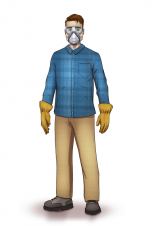Wildfires and Indoor Air Quality (IAQ)
Be Prepared to Evacuate
- Know how you will get emergency alerts and health warnings.
- Know your evacuation routes.
- Gather emergency supplies, including N95 respirator masks.
- Have at least a 5-day supply of food and medication on hand.
- Talk to your health care provider about what to do if you have heart or lung disease. If you have asthma, make sure you have an asthma action plan.
- Know how you will communicate with your family or other members of your household.
Información disponible en español
***NOTE 6/4/2020: This information was developed before the COVID-19 health emergency. Please supplement this information with the latest advice from state, local, Tribal and federal agencies, including the EPA website https://19january2021snapshot.epa.gov/coronavirus and CDC webpage https://www.cdc.gov/coronavirus/2019-ncov/index.html.***
During a wildfire, smoke can make the outdoor air unhealthy to breathe. Local officials may advise you to stay indoors during a smoke event. You should be aware that some of the smoke from outdoors can enter your home and make it unhealthy to breathe indoor air, too.
If you are close to a wildfire, the fire itself, as well as heavy smoke and ash, can pose serious, immediate risks to your safety and health. You and your family should be prepared to evacuate immediately if told to do so. Farther from a wildfire, you may be exposed to smoke even if the fire itself is far away.
Smoke is made up of a complex mixture of gases and fine particles produced when wood and other organic materials burn. The biggest health threat from smoke is from fine particles. These microscopic particles can get into your eyes and respiratory system – whether you are outdoors or indoors, where they can cause health problems such as burning eyes, runny nose, and illnesses such as bronchitis. Fine particles also can aggravate chronic heart and lung diseases - and even are linked to premature deaths in people with these conditions.
If you are healthy, you're usually not at a major risk from short-term exposures to smoke. Still, it's a good idea to avoid breathing smoke – both outdoors and indoors – if you can help it. Learn more about the health effects of wildfire smoke.
This page provides helpful information to reduce your exposure to wildfire smoke inside your home.
- How Does Wildfire Smoke Affect Indoor Air Quality?
- What Can I Do Now to Protect My Family from Wildfire Smoke?
- What Can I Do During a Wildfire Smoke Event to Reduce My Family's Exposure to Smoke Indoors?
- What Can I Do After a Wildfire Smoke Event to Protect My Family from Ash Indoors?
- Additional Resources
How Does Wildfire Smoke Affect Indoor Air Quality?
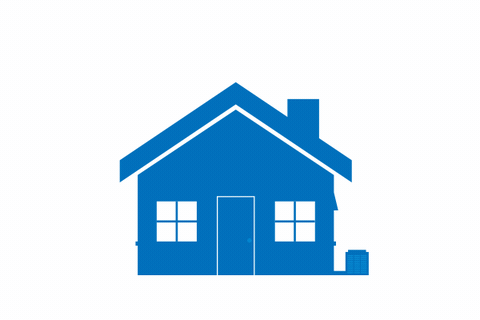 Ways that outdoor air can enter a home
Ways that outdoor air can enter a home
Outdoor air, including fine particles from wildfire smoke, can enter your home in a few ways:
- through open windows and doors, which is known as natural ventilation.
- through mechanical ventilation devices such as bathroom or kitchen fans that vent to the outdoors, or heating, ventilation and air conditioning (HVAC) systems with a fresh air intake.
- through small openings, joints, cracks, and around closed windows and doors through a process called infiltration.
Wildfire smoke could impact your indoor air quality (IAQ) differently depending on the proximity of the fire and the density of the smoke. Here are some situations you might experience and the actions you can take in each situation:
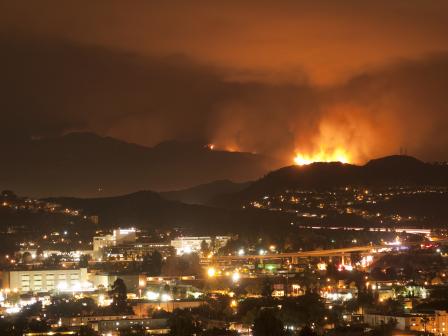 Active fire near buildings in Los Angeles, CA
Active fire near buildings in Los Angeles, CA
If there is an active fire in your area and it is very close to your house:
It may be best to evacuate. Fires can spread quickly and the smoke plume can make it difficult to see in an evacuation. In addition, it can be nearly impossible to keep dense smoke from building up in the indoor air. Pay close attention to local emergency alerts to know when to evacuate.
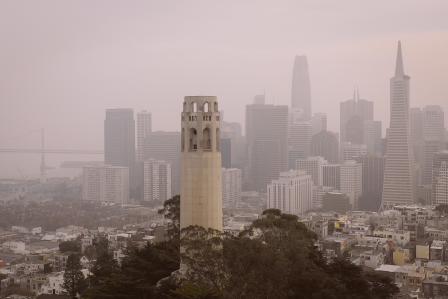 High smoke levels from a distant wildfire in San Francisco, CA
High smoke levels from a distant wildfire in San Francisco, CA
If there is an active fire close enough to cause high smoke levels, but the fire is not threatening your home:
Smoke may enter your home, making it harder to breathe. Learn more about what to do in this situation and how to prepare for it. If there is an active fire in your area, follow your local news, EPA's AirNow website, or your state air quality website for up-to-date information.
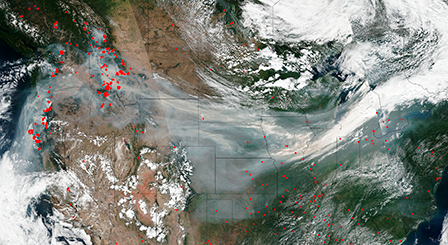 Wildfire smoke crossing the US on the jet stream. Actively burning areas are outlined in red. Image credit: NASA
Wildfire smoke crossing the US on the jet stream. Actively burning areas are outlined in red. Image credit: NASA
You may hear that smoke from a far-away wildfire has spread to your community, even if it is thousands of miles away.
While this can happen, the amount of smoke that may reach your community from such a distance is probably very small, and may be overshadowed by local sources of particle pollution. In this situation, you can monitor your local outdoor air quality on AirNow.gov and manage your indoor air quality as you normally would.
What Can I Do Now to Protect My Family from Wildfire Smoke?
If you live in an area where the wildfire risk is high, take steps now to prepare for fire season. Being prepared for fire season is especially important for the health of children, older adults, and people with heart or lung disease. The Prepare for Fire Season fact sheet describes the key steps you should take to make sure you are prepared to protect your family’s health in the event of a wildfire. FEMA’s How to Prepare for a Wildfire provides additional detail on how to protect yourself and your property.
Consider purchasing a portable air cleaner or high-efficiency HVAC Filter
You may decide to purchase a portable air cleaner or high efficiency HVAC system filter as part of your preparation in order to help improve your indoor air quality during a wildfire smoke event. If you decide to purchase a portable air cleaner, choose one that is sized for the room in which you will use it. Make sure the portable air cleaner does not make ozone. If you decide to purchase a high-efficiency HVAC filter, choose one with a Minimum Efficiency Reporting Value (MERV) 13 rating, or as high a rating as your system fan and filter slot can accommodate. You may need to consult a professional HVAC technician to determine the highest efficiency filter that will work best for your system.
You can find additional information about portable air cleaners and HVAC filters in the Indoor Air Filtration fact sheet and EPA’s Guide to Air Cleaners in the Home.
Consider purchasing N95 respirator masks
You should also consider keeping a supply of N95 respirator masks on hand. You can often purchase these masks in hardware stores or drugstores. The Protect Your Lungs from Wildfire Smoke or Ash fact sheet and this infographic will help you choose the correct mask and wear it effectively.
Know how to adjust your HVAC system or air conditioner to keep smoke out
It’s also a good idea to get familiar with your HVAC system or air conditioner system, if you have one, so you can adjust it to keep smoke out.
- If you have a central HVAC system, find out if it has a fresh air intake. If it does, find out how to close it or turn the system to recirculate mode. Make sure the HVAC filter is in good condition, fits snugly in the filter slot, and is replaced as recommended by the manufacturer. Consider upgrading to a MERV 13 or higher rated filter if your system can accommodate it.
- If you have a window air conditioner, find out how to close the outdoor air damper. If you cannot close the damper, consider preparing other cooling options like a fan. Make sure that the seal between the air conditioner and the window is as tight as possible.
- If you have a portable air conditioner with a single hose, typically vented out of a window, do not use it in smoky conditions. Consider other cooling options like a fan or window air conditioner. If you have a portable air conditioner with two hoses, make sure that the seal between the window vent kit and the window is as tight as possible.
What Can I Do During a Wildfire Smoke Event to Reduce My Family's Exposure to Smoke Indoors?
When wildfires create smoky conditions, there are things you can do, indoors and out, to reduce your family's exposure to smoke. Reducing exposure to smoke is important for everyone’s health — especially children, older adults, and people with heart or lung disease. The Reduce Your Smoke Exposure fact sheet describes what you can do.
If local officials advise you to stay indoors, take these actions in your home to reduce your smoke exposure:
- Keep windows and doors closed.
- Use fans and air conditioning to stay cool. If you cannot stay cool, seek shelter elsewhere.
- Reduce the smoke that enters your home.
- If you have an HVAC system with a fresh air intake, set the system to recirculate mode, or close the outdoor intake damper.
- If you have a window air conditioner, close the outdoor air damper. If you cannot close the damper, do not use the window air conditioner. Make sure that the seal between the air conditioner and the window is as tight as possible.
- If you have a portable air conditioner with a single hose, typically vented out of a window, do not use it in smoky conditions. If you have a portable air conditioner with two hoses, make sure that the seal between the window vent kit and the window is as tight as possible.
- Use a portable air cleaner or high-efficiency filter to remove fine particles from the air.
- If you use a portable air cleaner, run it as often as possible on the highest fan speed.
- If you have an HVAC system with a high-efficiency filter installed, run the system’s fan as often as possible to remove particles while the air quality is poor.
- Avoid activities that create more fine particles indoors, including:
- Smoking cigarettes.
- Using gas, propane or wood-burning stoves and furnaces.
- Spraying aerosol products.
- Frying or broiling food.
- Burning candles or incense.
- Vacuuming, unless you use a vacuum with a HEPA filter.
- Avoid strenuous activity during smoky times to reduce how much smoke you inhale.
- Create a clean room.
- Have a supply of N95 respirators and learn how to use them.
- Air out your home by opening windows or the fresh air intake on your HVAC system when the air quality improves, even temporarily.
What Can I Do After a Wildfire Smoke Event to Protect My Family from Ash Indoors?
After the smoke clears, you may need to clean up ash or other debris left behind by the fire. The Protect Yourself from Ash fact sheet describes how you can protect yourself and your family and avoid getting ash in the indoor air while cleaning up.
Children, older adults, and people with heart or lung diseases, such as asthma, should not participate in cleanup work. Cleanup work can expose you to ash and other products of the fire that may irritate your eyes, nose, or skin and cause coughing and other health effects.
Wear gloves, long-sleeved shirts, long pants, shoes and socks to avoid skin contact with ash. Wear an N95 respirator to protect your lungs from breathing in ash. Change your shoes and clothing before you leave the cleanup site to avoid tracking ash offsite, into your car, or other places. To avoid tracking ash into clean indoor spaces, use doormats and clean them regularly. Remove shoes indoors when possible.
Ash deposited on surfaces both indoors and outdoors can be inhaled if it becomes airborne when you clean up. Avoid stirring up or sifting through ash as much as you can. Avoid actions that kick ash particles up into the air, such as dry sweeping. Before sweeping indoor and outdoor hard surfaces, mist them with water to keep dust down. Follow with wet mopping. Use a damp cloth or wet mop on lightly dusted areas. When you wet down ash, use as little water as you can. If you choose to vacuum dusty surfaces, use a high-efficiency particulate air (HEPA)-type vacuum.
You may consider having your air ducts cleaned after a fire, but EPA recommends that air ducts only be cleaned as needed. For example, you should consider having the ducts cleaned if you find that your ducts are clogged with excessive amounts of dust and debris and/or particles are actually released into your home from the supply registers. For more information on air duct cleaning, including choosing a service provider, see Should You Have the Air Ducts in Your Home Cleaned?

